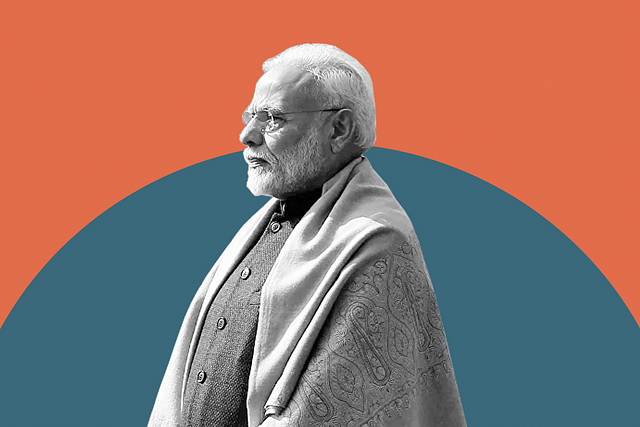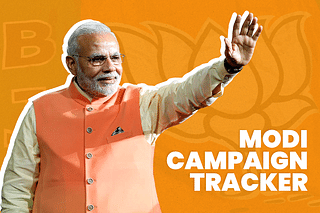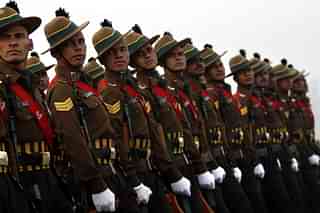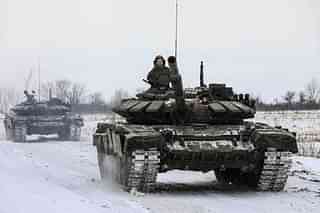Economy
Anna Yojana Is Modi's Pragmatic Alternative To Universal Basic Income
Prof. Vidhu Shekhar
Apr 29, 2024, 02:37 PM | Updated 03:19 PM IST
Save & read from anywhere!
Bookmark stories for easy access on any device or the Swarajya app.

In a world grappling with poverty and inequality, the concept of Universal Basic Income (UBI) — which involves a guaranteed payment given to all citizens, no strings attached — has been debated as a potential solution.
India, though, under Prime Minister Narendra Modi, has taken a noteworthy and unique approach. Through the Pradhan Mantri Garib Kalyan Anna Yojana (PMGKAY), the country is paving the way by providing basic food security to almost two-thirds of its citizens. This groundbreaking program is setting the stage for what could be known as Universal Basic Food (UBF), showcasing a practical and effective alternative to UBI.
The Grave Risks and Complications of Universal Basic Income
UBI, or giving a set amount of money regularly to every citizen, is often seen as a straightforward and uncomplicated method to fight poverty. However, as with many simple ideas, such a system can have grave risks and serious micro and macroeconomic complications.
On the individual/microeconomic level, making sure the money is used correctly and not spent on vices and that it doesn't discourage people from working can be quite the challenge. But, if we look at the larger picture, the macroeconomic risks could potentially be an even bigger hurdle.
At the macroeconomic level, unexpected Inflation, which can come from such handouts, is the gravest risk. Several advanced economies' provision for direct cash transfer during the COVID-19 pandemic crisis only resulted in great post-COVID inflation, the aftereffects of which are still very much being felt the world over.
Not only does inflation rock the stability of an economy, but it also makes the cash transfers themselves meaningless. This is because the rise in prices negates any benefits the transfers might bring. Something similar was witnessed by the MNREGA program in UPA-2 when untargeted cash infusion and non-monitoring of work done led to double-digit inflation in India. That inflation perhaps also became a strong reason for the subsequent major electoral loss for the incumbent government.
Over and above all this, the long-term fiscal sustainability of large-scale UBI programs remains a topic of debate among economists.
PMGKAY as an Alternative
Instead of following suit with other world economies and giving massive cash handouts, India, under PM Modi, took a different approach through PMGKAY — a program that could be described as on the path to Universal Basic Food (UBF). The scale of the program is truly mammoth and unparalleled in the world, with the government expected to spend approximately Rs 11.80 lakh crore in the next five years for the program.
Launched in March 2020 as a temporary relief measure during the COVID-19 pandemic, PMGKAY has since evolved into the world’s largest food security program.
Under this scheme, the government provides 5 kg of wheat or rice per person per month, along with 1 kg of pulses per family per month, free of cost to around 80 crore beneficiaries. The government has extended the program multiple times, with the latest extension to continue until 2028.
PMGKAY, as Universal Basic Food Scheme, shows clear differences in risk profile when compared to the direct cash handout programs of Universal Basic Income.
The first rationale is straightforward: by distributing food instead of cash, the government ensures that assistance is used precisely for the intended purpose — meeting the basic dietary needs of its citizens.
This direct provision of food also helps prevent the inflationary pressures that might arise from increased cash flow in the economy. We can already see the inflation outcome difference between countries that tried cash handouts through COVID-19 and suffered multi-decade high inflation — the US saw inflation numbers not seen since the 1980s. Compare this to India, which had Anna Yojana and where the inflation remained lower than even the recent highs of 2012 under the Congress-led UPA-2 government.
Economic and Social Benefits of UBF
While comprehensive, long-term data on PMGKAY's impact is still being gathered, early studies and economic models suggest several potential benefits.
In India, it is estimated that low and very low-income class spends around 30 per cent to 40 per cent on food expenses. PMGKAY thus helps save almost one-third of the income of the beneficiaries.
In a study based on a survey of ten talukas, researchers at Shivaji University, Kolhapur, found that the program directly led to increased social status and increased standard of living for the beneficiaries. A program of this scale can go a long way in eradicating multidimensional poverty from the country.
With the worry of securing daily food off their shoulders, beneficiaries of PMGKAY can redirect their energies towards more productive endeavours such as skill development and micro-entrepreneurship. This capability to focus on self-improvement and business can lead to widespread economic upliftment, especially among the poorest.
A study by the International Food Policy Research Institute found that every dollar invested in food security and nutrition in low-income countries can yield up to $16 in economic returns.
Apart from individual-level benefits and lower inflation, the program also leverages government procurement that leads to economies of scale that benefit the entire supply chain from farmers to consumers. This can help farmers by providing predictable demand and potentially contributing to more stable market prices, encouraging investment and productivity in the agricultural sector.
The program's success in reducing the direct and indirect costs associated with food insecurity is evident in its extension and planned continuation.
Global Implications and Lessons
India's approach to welfare through PMGKAY offers valuable lessons for other nations considering similar initiatives. The shift from cash-based assistance to direct provision of goods can lead to more efficient use of government resources, better-targeted welfare benefits, and enhanced economic stability.
India's model provides a blueprint for integrating economic policy with social welfare schemes for countries with significant agricultural sectors.
It must be noted that India’s Food Program complements other similar social benefit programs, such as PM Awas Yojana (for providing low-cost housing) and Ayushman Bharat (Health Insurance Scheme). Collectively, these programs form a converging and comprehensive social welfare system with far-reaching implications, and without the pitfalls of basic income schemes.
As the world continues to explore solutions to reduce poverty and ensure economic resilience, India's experiment with social welfare programs presents a compelling alternative that other nations might consider adapting to their specific contexts.
With PMGKAY, India is not just feeding its people — it is nurturing a future where economic and food security go hand in hand, demonstrating the power of innovative welfare strategies in the modern era.
Save & read from anywhere!
Bookmark stories for easy access on any device or the Swarajya app.
Dr Vidhu Shekhar, an ex-Investment banker and Hedge Fund analyst, is currently an Assistant Professor in the area of Finance & Economics at Bhavan's SPJIMR, Mumbai. He holds a Ph.D. (Economics) from IIM Calcutta, an MBA (2006) from IIM Calcutta, and a B.Tech (2004) from IIT Kharagpur. Views are personal.
Support Swarajya's 50 Ground Reports Project & Sponsor A Story
Every general election Swarajya does a 50 ground reports project.
Aimed only at serious readers and those who appreciate the nuances of political undercurrents, the project provides a sense of India's electoral landscape. As you know, these reports are produced after considerable investment of travel, time and effort on the ground.
This time too we've kicked off the project in style and have covered over 30 constituencies already. If you're someone who appreciates such work and have enjoyed our coverage please consider sponsoring a ground report for just Rs 2999 to Rs 19,999 - it goes a long way in helping us produce more quality reportage.
You can also back this project by becoming a subscriber for as little as Rs 999 - so do click on this links and choose a plan that suits you and back us.
Click below to contribute.





